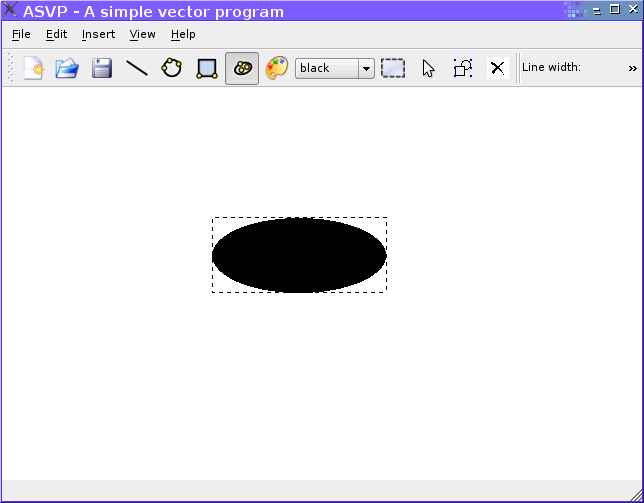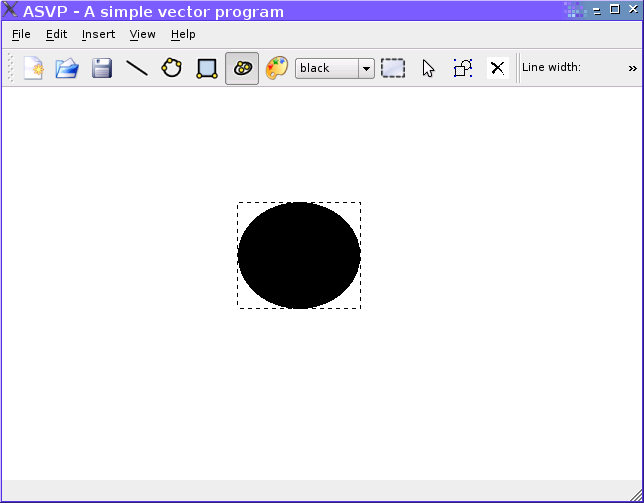Tindor
December 16, 2006, 5:37am
1
Hi,
void Ellipse::draw()
{ // glPushMatrix();
glLineWidth(this->line_width);
float xradius=(p2[0]-p1[0])/2;
float yradius=(p2[1]-p1[1])/2;
const float DEG2RAD = 3.14159/180;
glColor3f(color[0],color[1],color[2]);
glPushMatrix();
glTranslatef(p1[0],p1[1],0.0);
{ glTranslatef((p2[0]-p1[0])/2.0,(p2[1]-p1[1])/2.0,0.0);
glRotatef(rotationAngle,0,0,1);
glTranslatef(-(p2[0]-p1[0])/2.0,-(p2[1]-p1[1])/2.0,0.0);
}
if(scale!=1)
{
glScalef(scale,scale,scale);
}
glPolygonMode(GL_FRONT_AND_BACK, (isFilled)?GL_FILL:GL_LINE);
glBegin((isFilled)?GL_POLYGON:GL_LINE_LOOP);
for (int i=0; i < 360; i++)
{
float degInRad = i*DEG2RAD;
//glVertex2f(p1[0]+cos(degInRad)*xradius,p1[1]+sin(degInRad)*yradius);
glVertex2f(xradius+cos(degInRad)*xradius,yradius+sin(degInRad)*yradius);
}
cout << " is Filled: " << isFilled << endl;
glEnd();
And here’s how I initialize the GL widget:
void NeHeWidget::initializeGL()
{
glClearColor(1,1,1,0.0);
glClear(GL_COLOR_BUFFER_BIT | GL_DEPTH_BUFFER_BIT);
glLoadIdentity();
glBlendFunc(GL_SRC_ALPHA,GL_ONE_MINUS_SRC_ALPHA);
}
void NeHeWidget::resizeGL( int width, int height )
{
glViewport(0,0,width,height);
glMatrixMode(GL_PROJECTION);
glLoadIdentity();
GLfloat x= (GLfloat) width/height;
glFrustum(-x,x,-1.0,1.0,1.0,1.0);
glMatrixMode(GL_MODELVIEW);
}
dolf
December 17, 2006, 2:18am
2
The following obvious bugs:
in draw(), glPopMatrix is missing. This may lead to strange accumulations of matrices.
in glFrustum, you have near==far. It is surprising to me that you see anything at all.
The first one might be the reason for the observed behaviour. Otherwise, I’d check how p1, p2 are changed in the program as you rotate the ellipse.
Tindor
December 17, 2006, 2:40am
3
Well, I have glPopMatrix(), but it’s in the end of the function.
And here’s the full code of the function:
void Ellipse::draw()
{
glLineWidth(this->line_width);
float xradius=(p2[0]-p1[0])/2;
float yradius=(p2[1]-p1[1])/2;
const float DEG2RAD = 3.14159/180;
glColor3f(color[0],color[1],color[2]);
glPushMatrix();
glTranslatef(p1[0],p1[1],0.0);
{ glTranslatef((p2[0]-p1[0])/2.0,(p2[1]-p1[1])/2.0,0.0);
glRotatef(rotationAngle,0,0,1);
glTranslatef(-(p2[0]-p1[0])/2.0,-(p2[1]-p1[1])/2.0,0.0);
}
if(scale!=1)
{
glScalef(scale,scale,scale);
}
glPolygonMode(GL_FRONT_AND_BACK, (isFilled)?GL_FILL:GL_LINE);
glBegin((isFilled)?GL_POLYGON:GL_LINE_LOOP);
for (int i=0; i < 360; i++)
{
float degInRad = i*DEG2RAD;
//glVertex2f(p1[0]+cos(degInRad)*xradius,p1[1]+sin(degInRad)*yradius);
glVertex2f(xradius+cos(degInRad)*xradius,yradius+sin(degInRad)*yradius);
}
cout << " is Filled: " << isFilled << endl;
cout << "P1[0] " << this->p1[0] << " ";
cout << "P1[1] " << this->p1[1] << " ";
cout << "P2[0] " << this->p2[0] << " ";
cout << "P2[1] " << this->p2[1] << " ";
glEnd();
if(this->isSelected())
{
glEnable (GL_LINE_STIPPLE);
glLineStipple (4, 0xAAAA);
glBegin (GL_LINE_STRIP);
glVertex2f(0,0);
glVertex2f(p2[0]-p1[0],0);
glVertex2f(p2[0]-p1[0],p2[1]-p1[1]);
glVertex2f(0,p2[1]-p1[1]);
glVertex2f(0,0);
glEnd ();
glDisable(GL_LINE_STIPPLE);
}
glPopMatrix();
}
dolf
December 17, 2006, 5:11am
4
Could you try adding a glLoadIdentity() after glMatrixMode(GL_MODELVIEW)?
Tindor
December 17, 2006, 5:30am
5
I added it, but it feels the same - there’s no change of any kind.
jide
December 18, 2006, 10:04am
6
I guess it is due to the aspect ratio of your view. Did you tried other angles ? Did you tried other ellipsis ?
Also, don’t expect GL to explicitly transform the values of your vertices or so. It won’t.
But beforehand you should start from the basics, and specially about GL matrices: this code is somewhat pertining:
glTranslatef((p2[0]-p1[0])/2.0,(p2[1]-p1[1])/2.0,0.0);
glRotatef(rotationAngle,0,0,1);
glTranslatef(-(p2[0]-p1[0])/2.0,-(p2[1]-p1[1])/2.0,0.0);
You don’t need to explicitly ‘untranslate’.
I can suggest Nehe’s tutorials or the opengl red book. That will definately help you understand the main principles, that will help you work with this library.
Hope that helps.

